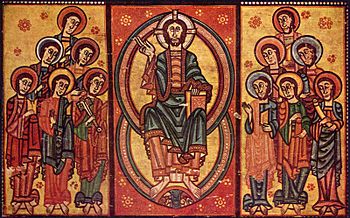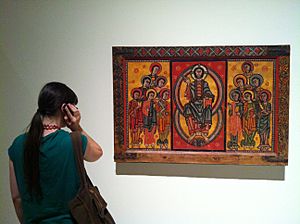Altar frontal from La Seu d'Urgell or of The Apostles facts for kids
Quick facts for kids Frontal from La Seu d'Urgell or of The Apostles |
|
|---|---|
 |
|
| Artist | Unknown |
| Year | 12th century |
| Medium | Tempera on pine wood |
| Dimensions | 102.5 cm × 151 cm (40.4 in × 59 in) |
| Location | Museu Nacional d'Art de Catalunya, Barcelona |
The Altar frontal from La Seu d'Urgell or of The Apostles is a very old and important piece of art. It is a special panel that used to cover the front of an altar in a church. This artwork was made around the 12th century, which is over 800 years ago! It comes from a church in a place called La Seu d'Urgell. Today, you can see it at the National Art Museum of Catalonia in Barcelona. It's considered one of the best examples of Romanesque art from that time.
This frontal is special because of its bright colors. It also shows some cool tricks artists used in Romanesque art. For example, it has "bilateral symmetry," meaning it's the same on both sides. The background is simple, without much detail about space. Also, the shapes of clothes look geometric, not natural. The artwork also uses "hierarchical perspective." This means the most important person in the painting is shown bigger than the others.
What Does This Artwork Show?

In the middle of the artwork, you see a figure called the Maiestas Domini, or Christ in Majesty. This means "Christ in Glory." He is shown inside a special oval shape called a "mandorla." This way of showing Christ was common in older art styles.
According to old stories, Christ's throne is like the sky, and the Earth is his footrest. His face has a serious look, and a cross shape is behind his head. He holds a book in his left hand and gives a blessing with his right hand.
Who Are the Figures?
On the sides of the artwork, you can see the Apostles. They are arranged in groups that look like pyramids. This was a clever way to fit many figures into the painting. Even though it looks new, this style was also seen in very old art and in famous Bibles from the 11th century.
All the Apostles are looking at Christ, either with their eyes or by tilting their heads. They are holding books or scrolls. You can spot St Peter because he is holding keys. Across from him is St Paul, who is easy to recognize by his bald head.
How Was It Made?
This altar frontal was painted using a technique called tempera. This is a type of paint made by mixing colors with egg yolk. The painting was done on a pine wood panel.
The artwork is a great example of Catalan Romanesque art. It shows key ideas of this style, like being the same on both sides (bilateral symmetry). It also uses geometric shapes, especially in how the clothes are folded. The bright, rich colors are also very impressive.
This artwork looks a lot like another altar frontal from a place called Saint Martin of Ix. They have similar colors and borders. This suggests that both artworks might have been made by the same artist or in the same art workshop.
See also
 In Spanish: Frontal de la Seo de Urgel o de los Apóstoles para niños
In Spanish: Frontal de la Seo de Urgel o de los Apóstoles para niños

